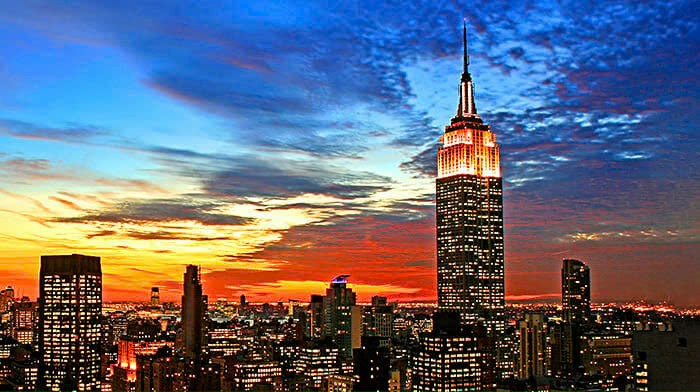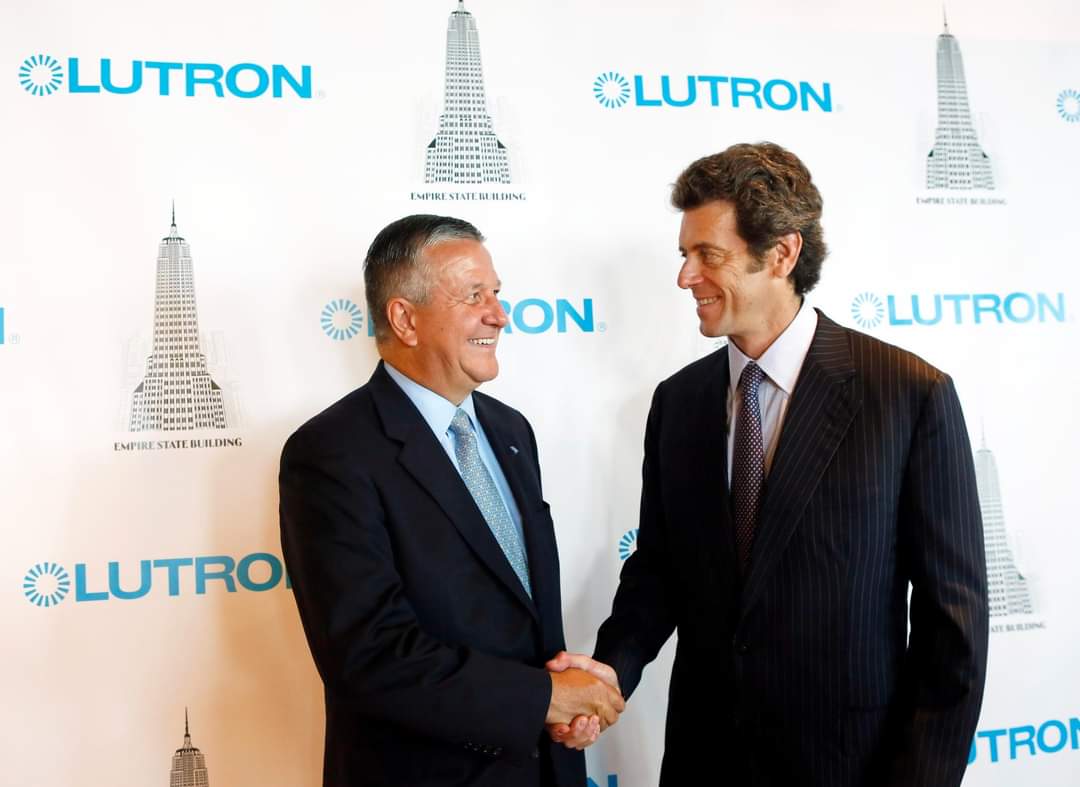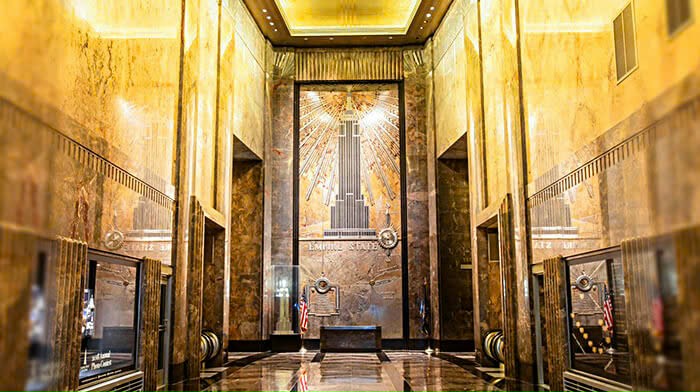Lutron Project Overview Empire State Building New York City
Lutron Project Overview Empire State Building New York City
Lutron helps the Empire State Building set a new standard for sustainable, commercial renovation.
In new commercial construction, sustainable building practices are becoming the norm, but, when it comes to renovating the more than 81-billion square feet (1) of existing office space in the world, owners and property managers face a process that can be much more difficult to navigate.
Ownership of the Empire State Building Company (ESB) has partnered with service providers and vendors to test and prove processes and products and provide guidelines for energy efficiency retrofits in existing buildings. Using its platform as the World’s Most Famous Office Building and its leadership in energy efficiency, ESB draws attention to pathways which are both economically viable and environmentally sustainable and available for any building, anywhere in the world. How better to set a new standard than to start with the revitalization of the world’s most recognizable structure... the Empire State Building.

Anthony Malkin of the Empire State Building Company is refreshingly upfront about his conviction that sustainability is multi-faceted,
“When we spend money, we want to be responsible stewards of the environment, but have to keep return on investment (ROI) top of mind. If a business is not profitable, it is not truly sustainable. At ESB, we want to create a road map for efficient retrofits and work with leading vendors who can create products that can help us reach our goals. Lutron has done that for light controls and developed a product we use, and any company can utilize in its renovation plan.”
Lutron daylight sensors in perimeter private offices, conference rooms corridors, and open-plan office spaces communicate wirelessly to EcoSystem® digital dimming ballasts to reduce or increase electric light levels based on available daylight, providing savings up to 60% (3) . Utilizing electric light to compliment daylight rather than as the prime light source in the space ensures that these areas are not over lit or using excess energy, but that lighting is always appropriate, facilitating comfortable working conditions.
Combined, these relatively simple, easily replicable strategies help reduce lighting electricity use by up to 65% (2).

Michael Pessina, president of Lutron Electronics (left) with Anthony Malkin of the Empire State Building Company (right).
"For more than 50 years, Lutron has been committed to energy savings and innovation. Our first priority as a company is to Take Care of the Customer, and Tony is helping us show the world how Lutron takes care of every customer, and takes care of the environment. We are proud to be a key part of his message. Mike Pessina" - Lutron president
The right steps in the right order...
Working with the team of Clinton Climate Initiative, Johnson Controls, Jones Lang LaSalle, and the Rocky Mountain Institute, ESB approached the building retrofit process by defining the right steps in the right order. Starting with the building core, engineers first worked to control building loads by eliminating potential for wasted energy. Every window in the facility was refurbished, radiative barriers were added to the exterior walls, and a more efficient lighting design was adopted to reduce lighting power density from 1W/Ft2 to .7W/ft2 . ESB’s overarching goal is to reduce energy use by more than the 38% guaranteed by its performance contract with Johnson Controls, Inc. when compared to a building that meets ASHRAE 90.1 code. Lighting in commercial buildings generally accounts for 39% of total building electricity use. By reducing lighting electricity use up to 65% (2) , Lutron light controls go a long way to helping ESB meet their efficiency goals.
The next step was to identify and install lighting and HVAC control systems that would support building goals. To control lighting in the pre-built tenant space, several different lighting control strategies were investigated and tested. The final, integrated solution is comprised of Lutron wireless light controls, wireless daylight and occupancy sensors, and digitally addressable dimming ballasts that combine to support sustainability goals, and create a highly desirable tenant space. To promote even greater energy savings, wireless occupancy sensors communicate with the Lutron dimming ballasts and the HVAC system, to turn lights off and reduce HVAC energy use when the space is unoccupied. Jones Lang LaSalle, project manager of ESB’s “Empire State ReBuilding” program, and Lutron, compared Lutron occupancy sensor strategies to simple time clock control, and found that by turning lights off in unoccupied areas during typical work hours, and not just after hours, the building saves nearly 38% more lighting electricity than it would with time clock control.
Daylighting addresses the opportunity to control light levels and energy use during work hours, but what about nighttime light levels? Common practice for night lighting involves keeping 20-25% of fixtures on at 100% light for security. The Lutron digital solution enables uniform night lighting throughout a space, but at very low levels such as 10% light output. This strategy uses less energy, while delivering a safer, more aesthetically appealing and inviting space. Controls communicate wirelessly via Lutron Clear Connect® radio frequency technology. In New York City, there is an exceptionally high concentration of cell phones, alarm systems, and other wireless devices. Lutron products operate on a quiet frequency, free of interference – another benefit to tenants who count on the building systems to perform consistently and seamlessly every day

Results
Beyond just performance, flexibility and energy savings in tenant spaces, wireless control reduces installation and operating costs to deliver an ROI under three years. “ROI is so important to meeting our goals, and to creating a replicable blueprint for success,” explains Dana Robbins Schneider of Jones Lang LaSalle, “When we first started investigating and testing light control solutions, we could meet our performance requirements, but we were facing a 6-year payback. An integrated, wireless and digital control solution from Lutron reduced that time period to 2.75 years, while enhancing building performance and flexibility.”
When considering light control solutions, a critical differentiator of the Lutron system was the company’s ability to support ESB contractors with training on new technologies, support to project designers and specifiers, and knowledgeable technical help to streamline project estimating, installation, and programming costs. “Lutron engineers were really with us every step of the way. They helped us to provide better project estimates, showed us how to install and program controls as efficiently as possible, and were available whenever we needed them,” says Dana Robbins Schneider of Jones Lang LaSalle.
The entire system is scalable and easily programmable. As tenants expand or change the layouts of their space, the light controls can easily change with them. Wireless control can be added to the system without rewiring, occupancy and daylight sensors can be moved or reconfigured easily, and entire spaces can be linked in whatever way makes sense to the tenants...multiple rooms, multiple areas, even multiple floors can be controlled together as the client’s needs are defined.
It is no surprise that ESB is the World’s Most Famous Office Building. It’s been featured in some of history’s most iconic films, is the ancestor of every tall building around the world, and is the international icon of the New York City skyline. Anthony Malkin wants to make sure it is also the world’s leading example of economic and environmental revitalization.
(1) Energy Information Administration, 2003 Commercial Buildings Energy Consumption Survey. Building Characteristics Tables, released December 2006. Online. Retrieved from http://www.eia.gov/emeu/cbecs/cbecs2003/detailed_tables_2003/2003set1/2…
(2) Although combined savings for a building from individual room strategies are not additive, solutions that utilize all strategies typically save 60% or more. Glenn Hughes, director of construction for The New York Times Company building in New York City reports 75% lighting energy savings using Lutron systems. Jeff Choma, manager of mechanical and electrical systems at Georgian College in Ontario, Canada reports 70% lighting energy savings using Lutron systems. Lighting energy savings exceeding 60% is frequently reported by customers using Lutron solutions as part of an overall energy-savings design program
(3) Brambley MR, et al. 2005. Advanced sensors and controls for building applications: Market assessment and potential R&D pathways. Pacific Northwest National Laboratory: prepared for U.S. Department of Energy
HOME FLOW SMART HOME | LUTRON PLATINUM DEALER IN VIETNAM
Showroom: 206/16 Nguyen Van Linh St., Ward Tan Thuan Tay, District 7, HCMC, Vietnam
Hotline: 18007027





